
Bee Brood Conditions
Sacbrood
Caused by a common bee viruses, sacbrood disease affects honey bee species around the world. Infected nurse bees likely pass the virus to larvae in brood food. Infected larvae fail to pupate after cells are capped, and remain on their backs in a distinct “canoe” posture. Larvae observed in uncapped cells may appear to have an abnormally small head, curved up, and changing color from gray to light brown then dark brown. Adult bees will remove dead larvae, which may spread the disease. If not removed, larvae dry out and adhere to the cell. If pulled from the cell with forceps, the larva will often appear as a bag of liquid, with one end a dark color. Adult bees exhibit no overt symptoms, although high viral levels may contribute to shorter lifespans and overall colony weakening.
Sacbrood is usually observed in spring colonies with a poor brood pattern. Symptoms may disappear in time, but can recur. No practical cure exists to treat honey bee viruses. Caging the queen for 2 weeks can break the transmission cycle to young bees. However, requeening the colony will usually clear up the infection by breaking the brood cycle and introducing new genetic stock, which may be more resistant.

Photo by Jon Zawislak

Photo by Michael E. Wilson
Larvae with characteristic symptoms of sacbrood virus. Infected larvae may be noticed in cells that have been chewed open because they failed to pupate.
American Foulbrood
American Foulbrood is caused by the bacteria Paenibacillus larvae, and is perhaps the most serious and lethal condition that can infect an apiary. Uncontrolled, it spreads easily to other hives, killing an entire apiary as weakened hives are robbed by stronger ones. The infection is caused by bacterial spores that are highly resistant to extremes of heat or cold, and can persist on old combs and woodenware for many decades. For this reason, it is unwise to use old beekeeping equipment with an unknown history. Only honey bee larvae are susceptible to AFB, while adult bees are immune. Nurse bees contaminate the larval food with bacteria, and larvae die soon after cells are capped.
AFB has distinct symptoms that can be recognized early. Capped brood cells may appear sunken, with perforated cappings. Also, the brood pattern appears spotty, rather than uniform. Dead larvae appear greasy and discolored at first, then darken as they decompose. These larval “scales” adhere to the bottoms of the cells, and are difficult for bees to remove. This disease is accompanied by a very unpleasant odor, for which it was named.
If American foulbrood is suspected, beekeepers can conduct a quick “ropiness” test in the field by inserting a toothpick or twig into a cell with a dead larva and stirring the tissue. When the toothpick is withdrawn, if the mixture strings out up to 3/4” before snapping back into the cell, it is very likely infected with AFB. Beekeepers should immediately contact their state apiary inspector to report the suspected presence of this disease, and follow all recommendations. An inspector will be able to confirm the diagnosis before taking further action.
There is no medical cure for American foulbrood, and most states’ laws require that infected colonies be destroyed and burned on site. While unfortunate, this is often the only practical way to prevent the disease from recurring or spreading to other hives. Other colonies in the apiary not showing symptoms should be placed under quarantine and reinspected at a later date. Feeding colonies a preemptive dose of antibiotics does not cure or prevent American foulbrood disease, but merely hides its symptoms.
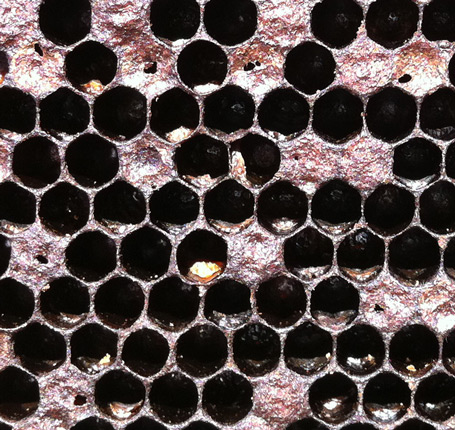
Sunken, perforated cappings and darkened scales on the bottoms of the cells are all symptoms of AFB infections. Photo by Jon Zawislak (uaex.uada.edu/bees).
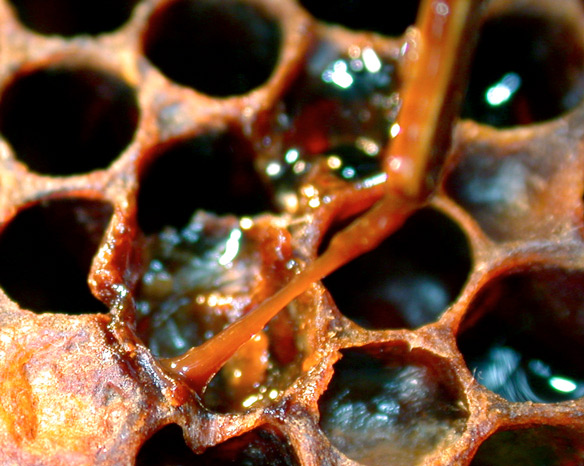
The “ropiness” test can be used in the field to quickly diagnose a case of American foulbrood. Any suspected case should be reported to a local apiary inspector. Photo by Virginia Williams, USDA-ARS.

Burning infected hives is the only practical solution to prevent the spread of AFB and is required by law in most states. Photo by Richard Underhill (peacebeefarm.blogspot.com).
European Foulbrood
European Foulbrood is caused by the bacteria Melissococcus plutonius. While not as serious as AFB, EFB is still very contagious and can be a serious threat. This pathogen is often present in seemingly healthy hives at a latent level, but becomes apparent only when colonies are under stress. It is most common in the critical period after winter when colonies contain many older bees, and are building up their populations at a time when weather is unpredictable and forage is not yet abundant. European foulbrood affects only younger larvae, when nurse bees accidentally contaminate brood food with the bacteria.
Infected larvae die before cells are capped, so the disease can be detected by inspecting the brood nest. The most obvious symptom is a spotty brood pattern, although this may not yet be apparent if the infection is at an early stage. Look carefully in individual open brood cells for discolored or deformed larvae. Infected larvae may appear off-white, yellow, brown or gray, possibly with tracheal tubes visible beneath the skin. Larvae may appear twisted or curled, or even melted down. A sour odor may or may not be apparent, depending on the progress of the disease. Dead larvae form a rubbery scale which worker bees can remove, but may not be able to keep up with a heavily-infected colony.
Brood infected with European foulbrood does not rope out when probed with a toothpick, as with AFB. It is important that beekeepers are able to recognize the difference in symptoms, because EFB-infected colonies do not need to be immediately destroyed, as with AFB.
Because EFB does not form long-lasting resistant spores, it is possible for a colony to recover from a mild infection. Antibiotics were traditionally used to successfully treat and control EFB, but the over-use of antibiotics in the animal industry has resulted in a federal law that now requires a licensed veterinarian to prescribe their use, even for beekeepers. It can be difficult to find a veterinarian able to immediately examine colonies, confirm the diagnosis, and prescribe medication as soon as EFB is discovered. Beekeepers can usually intervene to save their colony without the application of antibiotics by using the “shook swarm” technique.


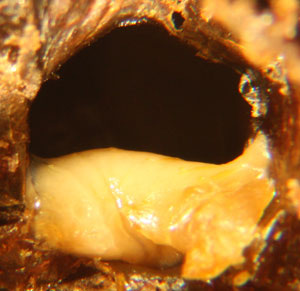
Visible symptoms of EFB infection include larvae that are discolored, twisted in their cells or appear to be melting down. These larvae will die before the cell is capped, and can be successfully removed by worker bees. Breaking the brood cycle helps to stop the cycle of disease transmission to susceptible larvae. Photos by Michael E. Wilson (beeinformed.org).
Cage or remove the queen for 2 weeks to break the brood cycle and prevent transmission of the disease to a new generation of susceptible larvae. During this broodless period, shake all adult bees onto new foundation in a clean hive, discard all brood combs (which serve as bacterial reservoirs), and feed the colony heavily with syrup. The syrup provides the worker bees with food and resources to draw new comb on the foundation. When the queen begins laying again, the disease should not recur. Replacing the queen during this period may also be beneficial, because a young queen is typically more prolific, and the new genetic stock may be more resistant to EFB. The use of antibiotics with this method described here may help to reduce the likelihood of a recurring infection. Applying antibiotics without discarding contaminated brood combs can rid the colony of symptoms, but the disease may recur later.
Chalkbrood
A condition known as chalkbrood disease is caused by a fungal pathogen, Ascosphaera apis, affecting larvae that have consumed spores. Infected larvae starve as the fungus grows within them and competes with the larvae for food. Dead larvae swell to fill their cells, and are quickly overgrown with fluffy fungal mycelia. The fungus produces spores, giving the dead larva a characteristic “chalky” look. These larvae, called mummies, may be found in capped or open cells, or on the bottom board, but are usually first noticed on the landing board after they have been removed by housecleaning bees. Mummies may appear white, gray, green, black, or a mixture of colors, as multiple other fungi tend to quickly grow on dead brood. This disease should not be confused with common molds, which readily grow on stored pollen if a colony dies during winter and remains unnoticed for a while.
There is no medication to treat for chalkbrood. It is most common in the early spring, and disappears when weather becomes warmer and drier, and as the queen increases spring brood production. Hygienic bees remove infected mummies, although this action can result in spreading spores throughout the brood area. A strong colony with abundant workers will be able to keep the brood nest cleaner. Also, a well-ventilated hive, elevated above the ground and free of excess moisture, can help prevent fungal growth. If this condition persists or recurs each year, beekeepers should thoroughly scrape and clean woodenware, replace old brood combs with new foundation, and sterilize hive tools.
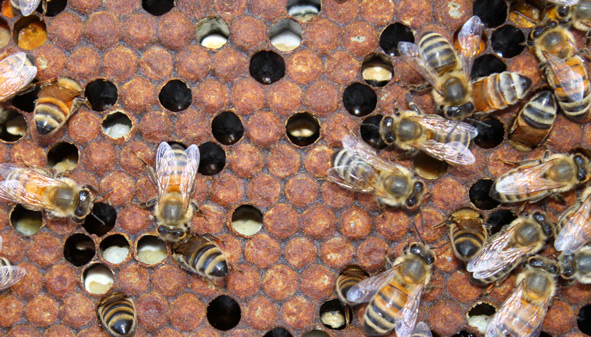
Photo by Rob Snyder (beeinformed.org).
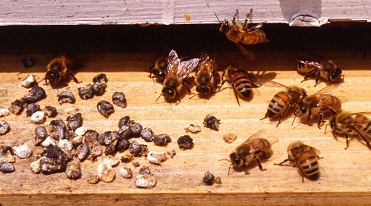
Photo by Jeff Pettis, USDA-ARS.
Chalkbrood mummies may be observed in brood cells (left) but are often first noticed on the landing board after housecleaning bees have begun removing them from the hive (right). There is no medical cure for chalkbrood.
Stonebrood
Another brood disease, stonebrood, is caused by several species of Aspergillus fungi. These soil-dwelling microbes are common insect pathogens, but good nutrition and overall colony health reduce physiological stress on bees and reduce the chance of infection from this and other microbes. The infection can grow rapidly, with an early symptom being a yellowish ring near the head end of the infected larva. Mummified larvae become coated with a film of yellow, green or black spores (depending on the fungal species), and become very hard and difficult to crush. Mummies may be found on the bottom board or at the hive entrance, similar to chalkbrood.
This disease is fairly rare, and the treatment for it is similar to chalkbrood. However, these fungal spores can cause respiratory infections in mammals, including humans, and combs from severely infected colonies should be carefully destroyed by burning.
Black Queen Cell Virus
This disease affects only developing queens, killing them after their cells are sealed. Unable to complete pupation, they appear similar to sacbrood-infected workers, initially turning yellow with a tough skin, then becoming significantly darker in color. After the pupating queen dies, the wall of the wax cell may appear dark and oily, indicating pupal mortality.
This virus is found world-wide, and is likely common at latent levels in many colonies. However, the condition is rarely seen outside of queen breeding operations that raise many queen cells from the same colonies. Workers and drones can carry infections, but do not develop visible clinical symptoms. The virus is likely transmitted from to queen larvae via the workers’ brood food glands, and it may be that the accumulation of abundant royal jelly from multiple infected nurse bees concentrates virus particles in the food which the queen larvae consume. BQCV has often been found in association with high levels of nosema, but a specific correlation is not clear. Viral incidence usually peaks in the early spring, when demand for queen production is very high, and hives may also still contain a large number of older overwintered bees, which tend to harbor more nosema spores. This virus has also been isolated from queen bees’ ovaries, and may be transmitted from infected queen to her offspring. While BQCV has also been detected in varroa mites, these parasites are not believed to be an important vector of the disease.

Photo by Rob Snyder (beeinformed.org)
Bald Brood
Bald brood is not a disease, but rather a symptom of a wax moth infestation. As small larvae of Galleria mellonella tunnel through combs, worker bees uncap brood cells in order to catch and kill the caterpillars. Patterns of uncapped cells are typically observed in straight rows, extending for several cells. These pupal cells are usually not capped again, but the bees inside continue to develop normally and emerge as adults. Small patches of bald brood should not concern the beekeeper, but attention should be focused on maintaining strong colonies and keeping hives sealed tightly, to prevent wax moths from entering. This condition should not be confused with hygienic behavior, in which brood cells are uncapped, and diseased or mite-infested pupae are removed.
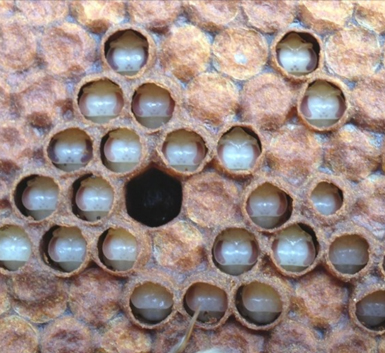
Bald brood describes a condition where worker bees uncap rows of sealed pupae to remove wax worms. Larvae will typically develop normally. Photo by Ashley Mortensen, University of Florida.
Hygienic Behavior
Adult bees will sometimes open capped brood cells and remove developing pupae. This hygienic behavior is thought to be a beneficial genetic trait that helps colonies resist diseases and mite infestations, and is being bred into queen stock to increase its expression in the managed bee population. Hygienic bees appear to uncap cells at random, likely in response to odor cues from the affected brood. Uncapped pupae are often observed to be “chewed down” and destroyed in the process of removing them. This differentiates the symptoms from bald brood, which are uncapped in straight rows and left to pupate untouched.
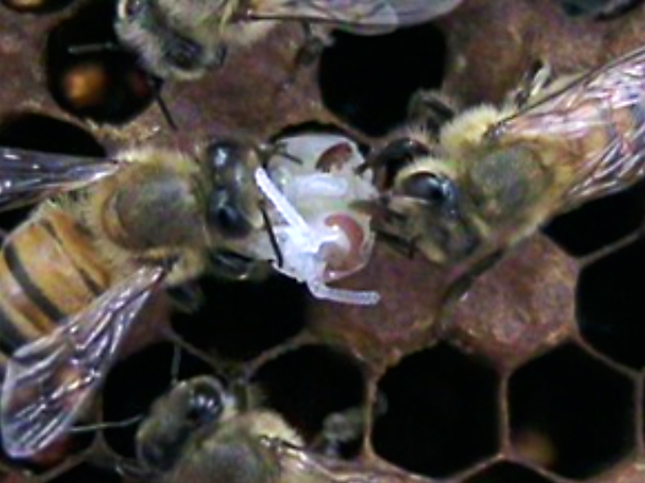
Hygienic workers removing a varroa-infested pupa from its cell. Photo by Jeffery Harris, Mississippi State University.
Parasitic Mite Syndrome (PMS)
This condition is not caused by a single specific pathogen, but is rather the result of a heavy parasitic mite infestation combined with a high load of one or more viruses. Together these factors can cause a colony’s bee population to dwindle due to reduced brood survival. Advanced cases will have such reduced adult bee populations that they cannot adequately feed a healthy queen or support substantial brood rearing, which leads to the colony’s eventual collapse. Queen supersedure is not uncommon.
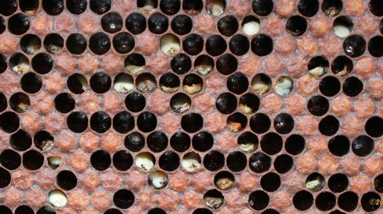
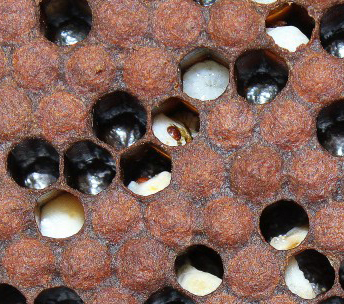
Colonies with PMS exhibit a spotty brood pattern, with dead or dying larvae visible in cells (left). Varroa may even be observed feeding in open brood cells (right). Photos by Michael E. Wilson (beeinformed.org).
Colonies with Parasitic Mite Syndrome exhibit a spotty brood pattern. Varroa mites may be visible on adult bees, may be seen crawling across sealed brood, or may even be observed feeding on larvae in open brood cells. Larvae in open cells may appear off-color and melting down. Symptoms can appear similar to those of European foulbrood, except that the brood in this case may be at different stages of development. Colonies that exhibit hygienic behavior may open capped cells and chew down these pupae.
Colonies with PMS often suffer from multiple viruses, usually transmitted by varroa mites. Bees infected with deformed wing virus (DWV) may or may not be observed crawling around at the hive entrance or on the ground, unable to fly. Many viral infections however, do not exhibit visible symptoms in adult bees. Because the overall health and immune response of the colony has been impacted by mites, other disease symptoms may also be observed, such as chalkbrood, sacbrood or European foulbrood. Beekeepers should consider consolidating the hive into a smaller space the remaining bees can protect. Give supplemental food if needed. Breaking the brood cycle can disrupt disease transmission and mite reproduction. An effective mite treatment is advisable.

Click the 'X' to exit fullscreen.